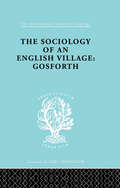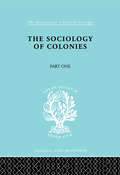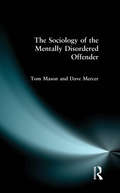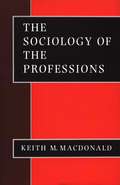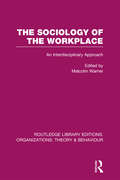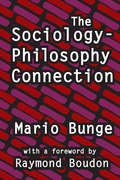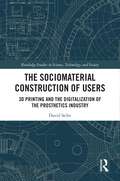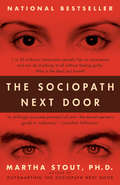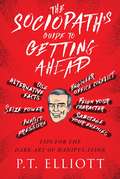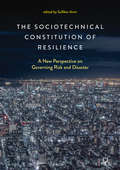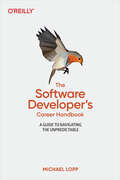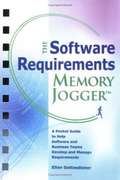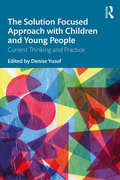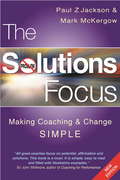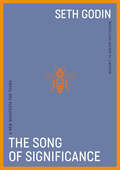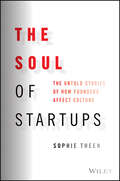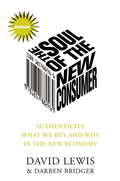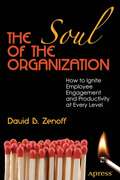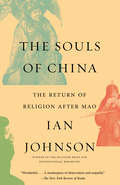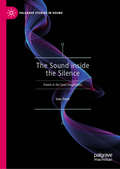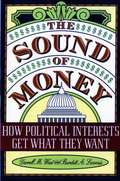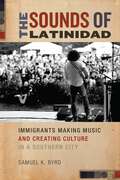- Table View
- List View
The Sociology of an English Village: Gosforth (International Library of Sociology)
by W. M. WilliamsFirst Published in 1998. Routledge is an imprint of Taylor & Francis, an informa company.
The Sociology of the Colonies [Part 1]: An Introduction to the Study of Race Contact (International Library of Sociology)
by Rene MaunierFirst published in 1998. Routledge is an imprint of Taylor & Francis, an informa company.
The Sociology of the Individual: Relating Self and Society
by Athanasia ChalariWhat it socialization? What is interaction? What do we mean by identity? How can we explain the notion of self? What do we mean by intra-action? The Sociology of the Individual is an innovative and though-provoking sociological exploration of how the ideas of the individual and society relate. Expertly combining conceptual depth with clarity of style, Athanasia Chalari: explains the key sociological and psychological theories related to the investigation of the social and the personal analyses the ways that both sociology and psychology can contribute to a more complete understanding and theorising of everyday life uses a mix of international cases and everyday examples to encourage critical reflection. The Sociology of the Individual is an essential read for upper level undergraduates or postgraduates looking for a deeper and more sophisticated understanding of the connection between the social world and the inner life of the individual. Perfect for modules exploring the sociology of the self, self and society, and self and identity.
The Sociology of the Individual: Relating Self and Society
by Athanasia ChalariWhat it socialization? What is interaction? What do we mean by identity? How can we explain the notion of self? What do we mean by intra-action? The Sociology of the Individual is an innovative and though-provoking sociological exploration of how the ideas of the individual and society relate. Expertly combining conceptual depth with clarity of style, Athanasia Chalari: explains the key sociological and psychological theories related to the investigation of the social and the personal analyses the ways that both sociology and psychology can contribute to a more complete understanding and theorising of everyday life uses a mix of international cases and everyday examples to encourage critical reflection. The Sociology of the Individual is an essential read for upper level undergraduates or postgraduates looking for a deeper and more sophisticated understanding of the connection between the social world and the inner life of the individual. Perfect for modules exploring the sociology of the self, self and society, and self and identity.
The Sociology of the Mentally Disordered Offender
by Tom Mason Dave MercerIn recent years mentally disordered offenders have attracted considerable attention in the media and there has been heated public debate as to the best treatment and prevention of re-offending. Simultaneously there has been a significant increase in the amount of research, specialist courses and training devoted to this particular, high profile area of mental health care. This is as a result of considerable public pressure to develop effective theory and practice for diagnosing and treating this patient group.A Sociology of the Mentally Disordered Offender provides a concise, and most importantly, accessible guide to the main theoretical issues from a sociological perspective as a counterbalance to the predominant medical model. Having established a theoretical framework through the exploration of topics such as the relationship between crime and mental disorder the authors look at the processes by which offenders are referred either to criminal justice or the mental health service system, their subsequent treatment and management, and the problem of re-offending. A final chapter looks at ways in which care and management of these patients may be effectively developed in the future.
The Sociology of the Professions: SAGE Publications
by Professor Keith M MacdonaldThis much-needed book provides a systematic introduction, both conceptual and applied, to the sociology of the professions. Keith Macdonald guides the reader through the chief sociological approaches to the professions, addressing their strengths and weaknesses. The discussion is richly illustrated by examples from and comparisons between the professions in Britain, the United States and Europe, relating their development to their cultural context. The social exclusivity that professions aim for is discussed in relation to social stratification, patriarchy and knowledge, and is thoroughly illustrated by reference to examples from medicine and other established professions, such as law and architecture. The themes of the book are drawn together in a final chapter by means of a case study of accountancy.
The Sociology of the Workplace: Organizations: Sociology Of The Workplace: An Interdisciplinary Approach (Routledge Library Editions: Organizations)
by Malcolm WarnerThis volume adopts an interdisciplinary approach. The study of the workplace is approached from the standpoint of industrial sociology, industrial relations, industrial anthropology and other related disciplines. It includes contributions from economists and psychologists as well as from sociologists. The theoretical and practical issues raised, are, however, central to the sociological tradition of Marx and Weber in that they concern the meaning of human and social phenomena and their relevance to resolving questions of moment in industrial and industrializing societies.
The Sociology-philosophy Connection
by Mario BungeMost social scientists and philosophers claim that sociology and philosophy are disjoint fields of inquiry. Some have wondered how to trace the precise boundary between them. Mario Bunge argues that the two fields are so entangled with one another that no demarcation is possible or, indeed, desirable. In fact, sociological research has demonstrably philosophical pre-suppositions. In turn, some findings of sociology are bound to correct or enrich the philosophical theories that deal with the world, our knowledge of it, or the ways of acting upon it.While Bunge's thesis would hardly have shocked Mill, Marx, Durkheim, or Weber, it is alien to the current sociological mainstream and dominant philosophical schools. Bunge demonstrates that philosophical problematics arise in social science research. A fertile philosophy of social science unearths critical presuppositions, analyzes key concepts, refines effective research strategies, crafts coherent and realistic syntheses, and identifies important new problems.Bunge examines Marx's and Durkheim's thesis that social facts are as objective as physical facts; the so-called Thomas theorem that refutes the behaviorist thesis that social agents react to social stimuli rather than to the way we perceive them; and Merton's thesis on the ethos of basic science which shows that science and morality are intertwined. He considers selected philosophical problems raised by contemporary social studies and argues forcefully against tolerance of shabby work in academic social science and philosophy alike.
The Sociomaterial Construction of Users: 3D Printing and the Digitalization of the Prosthetics Industry (Routledge Studies in Science, Technology and Society)
by David SeibtThis book explores the intricate connections that link the current digitalization of manufacturing to our daily lives and identities as members of highly technologized societies. Based on extensive research on the prosthetics industry in Germany, the US, Canada, and Haiti, the author analyzes the sociomaterial construction of users, by demonstrating the ways in which the introduction of 3D printing changes how artificial limbs are designed, manufactured, distributed, and used. Critically examining the capacity of digital technologies to afford greater diversity of user roles, enable the inclusion of marginalized groups, and increase user participation in the innovation process, the author presents a theory of user construction that sheds light on the dynamic relationship between industrial digitalization and the future of use. An empirically grounded and conceptually informed study, The Sociomaterial Construction of Users will appeal to researchers in the fields of sociology, science and technology studies, and organization studies, as well as readers interested in 3D printing and the digitalization of society.
The Sociopath Next Door: The Ruthless versus the Rest of Us
by Martha StoutWho is the devil you know? <P><P> Is it your lying, cheating ex-husband? Your sadistic high school gym teacher? Your boss who loves to humiliate people in meetings? The colleague who stole your idea and passed it off as her own? <P> In the pages of The Sociopath Next Door, you will realize that your ex was not just misunderstood. He's a sociopath. And your boss, teacher, and colleague? They may be sociopaths too. <P> We are accustomed to think of sociopaths as violent criminals, but inThe Sociopath Next Door, Harvard psychologist Martha Stout reveals that a shocking 4 percent of ordinary people--one in twenty-five--has an often undetected mental disorder, the chief symptom of which is that that person possesses no conscience. He or she has no ability whatsoever to feel shame, guilt, or remorse. One in twenty-five everyday Americans, therefore, is secretly a sociopath. They could be your colleague, your neighbor, even family. And they can do literally anything at all and feel absolutely no guilt. <P> How do we recognize the remorseless? One of their chief characteristics is a kind of glow or charisma that makes sociopaths more charming or interesting than the other people around them. They're more spontaneous, more intense, more complex, or even sexier than everyone else, making them tricky to identify and leaving us easily seduced. Fundamentally, sociopaths are different because they cannot love. Sociopaths learn early on to show sham emotion, but underneath they are indifferent to others' suffering. They live to dominate and thrill to win.<P> The fact is, we all almost certainly know at least one or more sociopaths already. Part of the urgency in reading The Sociopath Next Door is the moment when we suddenly recognize that someone we know--someone we worked for, or were involved with, or voted for--is a sociopath. But what do we do with that knowledge? To arm us against the sociopath, Dr. Stout teaches us to question authority, suspect flattery, and beware the pity play. Above all, she writes, when a sociopath is beckoning, do not join the game. <P> It is the ruthless versus the rest of us, and The Sociopath Next Door will show you how to recognize and defeat the devil you know.
The Sociopath's Guide to Getting Ahead: Tips for the Dark Art of Manipulation
by P. T. ElliottCan you be manipulative or irresponsible? Do you occasionally experience a lack of guilt or empathy? Can you be impulsive and feel a need for excitement? Well, these traits are the hallmarks of the sociopath inside you, and it’s time to embrace it! The time to unleash your inner sociopath has never been more right—just look at today’s world leaders and most popular personalities. And it’s time to get yours. Shoot up the promotional ladder and become the predator at the top of the corporate food chain with The Sociopath’s Guide to Getting Ahead. Find the perfect job for the sociopath in you, fabricate your resume to perfection, and manufacture the perfect first impression to ace those interviews. Prey on the biases and manipulate the psychology of your coworkers to break them down. Engineer conflict, manipulate the flow of attention, and seize power for yourself. Play the office party to perfection. Learn how to fake naturalness, make the right allies, and take down your enemies. And take it all the way to the bank. A scathing, tongue-in-cheek take on Dale Carnegie's How to Win Friends and Influence People, the self-help industry, and our world today, featuring cameos by Dostoyevsky, Plato, Robert Greene, Malcolm Gladwell and many others, The Sociopath’s Guide to Getting Ahead is the practical satire we need.
The Sociotechnical Constitution of Resilience: A New Perspective On Governing Risk And Disaster
by Sulfikar AmirThis book considers the concept of resilience in a global society where coping with the consequence and long term impact of crisis and disaster challenges the capacity of communities to bounce back in the event of severe disruption. Catastrophic events such as the 9.11 terrorist attack, the Fukushima nuclear disaster, and the volcano eruption in Central Java entailed massive devastation on physical infrastructures, and caused significant social and economic damage. This book considers how the modern sociotechnological system facilitating human activity defines how societies survive and whether a crisis will be short-lived or prolonged. Drawing on the concept of sociotechnical resilience, this book closely examines a range of events North America, Asia, Australia, and Europe. By presenting the successes and failures of sociotechnical resilience, it offers important insights and practical lessons to build better and comprehensive understandings of resilience in a real-world setting, significantly contributing to the study of disaster resilience.
The Software Developer's Career Handbook: A Guide to Navigating the Unpredictable
by Michael LoppAt some point in your career, you'll realize there's more to being a software engineer than dealing with code. Is it time to become a manager? Or join a startup? In this insightful and entertaining book, Michael Lopp recalls his own make-or-break moments with Silicon Valley giants such as Apple, Slack, Pinterest, Palantir, Netscape, and Symantec to help you make better, more mindful career decisions.With more than 40 stand-alone stories, Lopp walks through a complete job lifecycle, starting with the interview and ending with the realization that it might be time to move on. You'll learn how to handle baffling circumstances in your job, understand what you want from your career, and discover how to thrive in your workplace.Learn how to navigate areas of your job that don't involve writing codeIdentify how the aspects you enjoy will affect your next career stepsBuild and maintain key relationships and interactions within your communityMake choices that will help you have a "deliberate career"Recognize what's important to your manager and work on things that matter
The Software Requirements Memory Jogger: A Pocket Guide to Help Software and Business Teams Develop and Manage Requirements
by Ellen GottesdienerThe Software Requirements Memory Jogger is an easy-to-use guide for developing and managing precise software requirements. The Software Requirements Memory Jogger provides every member of your project team with the tools and techniques to foster communication between business and technical teams on the necessary requirements for producing successful software. The Software Requirements Memory Jogger will benefit all stakeholders at any organizational level involved in software development projects management team, practitioners, QA/QC personnel. - Explore practical steps, tips, and examples to help you develop and manage requirements - Follow the User Requirements Roadmap a toolkit of techniques for discovering and analyzing user requirements - Streamline communications between all requirements stakeholders - Learn how to write clear, concise requirements documents
The Solution Focused Approach with Children and Young People: Current Thinking and Practice
by Denise YusufThe Solution Focused Approach with Children and Young People: Current Thinking and Practice brings together leading figures and innovative practitioners from different professions, contexts and countries to provide a unique overview of Solution Focused work with children and young people. Presenting a range of applications in individual, group and community work, it puts the spotlight on diverse fields, exploring how the Solution Focused approach can work in real-world contexts. This book showcases a powerful, engaging approach which helps children and young people find the resources and strengths to manage difficulties and make the most of their lives. It contains interesting case studies, narrative descriptions of original practice, programmes of work developed using Solution Focused principles, and thought-provoking discussions of key elements of practice. With chapters presenting perspectives from coaching, therapy, consultancy and education, and applications including learning assessments, child protection, bereavement, edge of care, and youth offending, the book provides an overview of the current state of practice and provides pointers to potential new developments. The Solution Focused Approach with Children and Young People will help both experienced practitioners and those new to the approach to develop and update their knowledge and skills, as well as introducing them to creative and cutting-edge tools to inspire fresh ideas and thinking. It will be essential reading for Solution Focused practitioners and students, as well as coaches, social workers, school counsellors and mental health professionals working with children and young people.
The Solutions Focus: Making Coaching and Change SIMPLE (People Skills For Professionals Ser.)
by Paul Z. Jackson Mark McKergowThis is a new and updated edition of this acclaimed first business book on the powerful, simple yet subtle approach to positive change in people, teams and organisations. Used around the world by a wide range of people, professions and organisations, the first edition has now sold nearly 10,000 copies and been translated into 7 languages. Including new chapters reflecting the increasing importance of coaching and the solutions focus movement in the business environment, this wide-ranging book is filled with all the most important ideas, case examples and practical tips for managers, facilitators and consultants. Proven in many fields and with a distinguished intellectual heritage, "The Solutions Focus" provides a simple and direct route to progress in your organisation. It focuses on: solutions - not problems; in between: the action is in the interaction; make use of what's there; possibilities - past, present and future; and language. Every case is different. The trouble with traditional approaches to people problems is that they assume a straightforward relationship between cause and effect, between a problem and its solution. A solutions-focused approach sidesteps the search for the causes of a problem and heads straight for the solution, showing you how to envisage your preferred future and quickly takes steps forward. The authors present a set of practical techniques, including specific forms of questioning that lead to immediate action and results. They show how to identify what is working in your organisation and amplify it to make useful changes; to focus on what is possible rather than what is intractable and how to be solution focused, not solution forced.
The Song of Significance: A New Manifesto for Teams
by Seth GodinA soulful re-envisioning of what work and leadership can be, from the visionary mind of renowned author and thought leader, Seth GodinThe Song of Significance is a rousing contemplation on work: why it is the way it is, why it&’s gotten so bad, what all of us–especially leaders–can do to make it better.Economic instability and the rise of remote work have left us disconnected and disengaged. Alarmed managers are responding with harsh top-down edicts, layoffs, surveillance and mandatory meetings. Workers are responding by quiet quitting and working their wage. But it doesn't have to be this way.Through 144 provocative stanzas, legendary business author Seth Godin gets to the heart of what ails us; he shows what&’s really at the root of these trends, and challenges us to do better in ways that matter.The choice is simple. We can endure the hangover of industrial capitalism, keep treating people as disposable, and join in the AI-fueled race to the bottom. Or we come together to build a significant organization that enrolls, empowers, and trusts everyone to deliver their best work, no matter where they are.This is a book to share with bosses and co-workers, to discuss and put to action. No matter what our role, it&’s within our power to change. Because, as Godin writes, &“Humans aren&’t a resource. They are the point.&”
The Sopranos
by Franco RicciOften hailed as one of the greatest television series of all time, The Sopranos is a product of its time, firmly embedded in the problems of post-industrial, post-ethnic America. In The Sopranos: Born under a Bad Sign, Franco Ricci examines the groundbreaking HBO series and its impact as a cultural phenomenon.Ricci demonstrates an encyclopedic knowledge of the series, the genre, and their social context in his analysis of the show's complex themes and characters. He explores The Sopranos' deep engagement with problems of race, class, gender, and identity, specifically in its portrayal of the Italian-American experience, consumer and media-driven society, and contemporary psychosocial issues. The series' protagonist, Mafia boss and patriarch Tony Soprano, in many ways embodies the anxieties of our age. Focusing on Tony's internal struggles and interactions with his therapist, family, and associates, Ricci traces this archetypal character's existential conflicts and sheds light on his search for self, connection, and meaning.Comprehensive in scope and sophisticated in approach, The Sopranos: Born under a Bad Sign is richly rewarding reading for anyone with an interest in the popular television drama, both as entertainment and social commentary.
The Soul of Startups: The Untold Stories of How Founders Affect Culture
by Sophie TheenDiscover how a founder&’s personality can impact the culture of a startup In The Soul of Startups: The Untold Stories of How Founders Affect Culture, award-winning HR and diversity and inclusion professional Sophie Theen delivers an insightful and eye-opening discussion of the importance of culture in the vibrant and, sometimes, chaotic world of startup enterprise. In the book, you&’ll hear from a people management expert who has sat alongside those who launch exciting new ventures. The author describes company founders who lacked the emotional maturity and intelligence to start an organization on which an entire team would rely for their wellbeing, as well as those who excelled at creating environments that allowed their team members to thrive, personally and professionally. You&’ll also find: Unvarnished truths from people who have lived through the ups and downs of the startup experience Celebrations of the people who have worked for—and with—the celebrity CEOs to help them realize their vision Illuminating stories of the journeys of startup operators, including the good, the bad, and the uglyA can&’t-miss resource for company founders, entrepreneurs, managers, executives, and startup professionals, The Soul of Startups also belongs in the libraries of human resources and people management professionals seeking unique insights into how the personalities of startup founders shape the structures, processes, and realities of working in a fast-growing company.
The Soul of the New Consumer
by David Lewis Darren BridgerNew consumers are revolutionizing the world of business, our culture norms and our social expectations. No longer confined by gender, age, ethnicity or income, new consumers are breaking down barriers, shattering stereotypes and redefining the marketplace and the very meaning of consumerism. From traditional to online retailing, from tracking "coolhunters" to exploring "tastespace," The Soul of the New Consumer: Authenticity - What We Buy and Why in the New Economy by David Lewis and Darren Bridger unearths the essence of new consumer behavior, explores the drive for authenticity over commodity and goes far beyond the simple concepts of how and what to answer the most important question of all - why? In an affluent world saturated with affordable products there are three new scarcities - time, attention and trust. Over the past decade, Lewis and Bridger have been at the forefront of researching these new consumers and, here, they report their observations. For companies large and small, no matter what their service or product, The Soul of the New Consumer provides the first profile of the independent, involved and well-informed new consumer who is challenging the way marketing, selling and business are done.
The Soul of the Organization
by David B. ZenoffUsing Mac OS Mavericks ?is the essential guide to using a computer running Mavericks, providing a complete resource for both the beginner and the enthusiast. Techniques are step-by-step using photography and screen prints throughout, together with concise, easy to follow text from an established expert in the field, provide a comprehensive guide to Apple Macs. Whether you have just bought your first Mac, switched from Windows, or are a keen computer user, this book will provide you with a firm grasp of the underpinning foundations and equip you with the skills needed to use a Mac like a pro. ?
The Souls of China: The Return of Religion After Mao
by Ian JohnsonFrom the Pulitzer Prize–winning journalist, a revelatory portrait of religion in China today—its history, the spiritual traditions of its Eastern and Western faiths, and the ways in which it is influencing China’s future. The Souls of China tells the story of one of the world’s great spiritual revivals. Following a century of violent anti-religious campaigns, China is now filled with new temples, churches, and mosques—as well as cults, sects, and politicians trying to harness religion for their own ends. Driving this explosion of faith is uncertainty—over what it means to be Chinese and how to live an ethical life in a country that discarded traditional morality a century ago and is searching for new guideposts.Ian Johnson first visited China in 1984; in the 1990s he helped run a charity to rebuild Daoist temples, and in 2001 he won a Pulitzer Prize for his coverage of the suppression of the Falun Gong spiritual movement. While researching this book, he lived for extended periods with underground church members, rural Daoists, and Buddhist pilgrims. Along the way, he learned esoteric meditation techniques, visited a nonagenarian Confucian sage, and befriended government propagandists as they fashioned a remarkable embrace of traditional values. He has distilled these experiences into a cycle of festivals, births, deaths, detentions, and struggle—a great awakening of faith that is shaping the soul of the world’s newest superpower.
The Sound inside the Silence: Travels in the Sonic Imagination (Palgrave Studies in Sound)
by Seán StreetIn this poetic exploration of the auditory imagination, the third in his series on sonic aesthetics, Seán Street peoples silence with sound, travelling through time and space to the distant past, the infinite future and the shadow lands of the inner psyche. Our mind is a canvas on which the colours of the sound world leave permanent impressions. It is the root of all listening.
The Sound of Money: How Political Interests Get What They Want
by Darrell M. West Burdett A. LoomisIn their compelling new book, The Sound of Money: How Political Interests Get What They Want, West and Loomis probe the connection between interest-group spending and congressional policy making. In recent years, important battles have been fought over health care reform, telecommunications deregulation, and Medicare, to name just a few. The interest groups most successful at influencing policy are those with the most money to spend on advertising and lobbying. West and Loomis caution that as the "sound" of money in American politics grows louder, this new group activism will increasingly affect-and maybe even threaten-the viability of representative government.
The Sounds of Latinidad: Immigrants Making Music and Creating Culture in a Southern City (Social Transformations in American Anthropology #4)
by Samuel K. ByrdThe Sounds of Latinidad explores the Latino music scene as a lens through which to understand changing ideas about latinidad in the New South. Focusing on Latino immigrant musicians and their fans in Charlotte, North Carolina, the volume shows how limited economic mobility, social marginalization, and restrictive immigration policies have stymied immigrants' access to the American dream and musicians' dreams of success. Instead, Latin music has become a way to form community, debate political questions, and claim cultural citizenship. The volume illuminates the complexity of Latina/o musicians' lives. They find themselves at the intersection of culture and politics, often pushed to define a vision of what it means to be Latino in a globalizing city in the Nuevo South. At the same time, they often avoid overt political statements and do not participate in immigrants' rights struggles, instead holding a cautious view of political engagement. Yet despite this politics of ambivalence, Latina/o musicians do assert intellectual agency and engage in a politics that is embedded in their musical community, debating aesthetics, forging collective solidarity with their audiences, and protesting poor working conditions. Challenging scholarship on popular music that focuses on famous artists or on one particular genre, this volume demonstrates how exploring the everyday lives of ordinary musicians can lead to a deeper understanding of musicians' role in society. It argues that the often overlooked population of Latina/o musicians should be central to our understanding of what it means to live in a southern U.S. city today.
